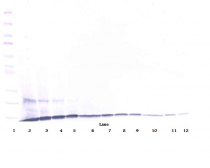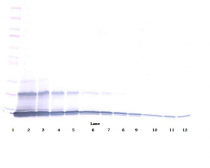ARG66041
anti-CCL23 antibody
anti-CCL23 antibody for ELISA,Neutralizing,Western blot and Human,Mouse
Overview
| Product Description | Rabbit Polyclonal antibody recognizes CCL23 |
|---|---|
| Tested Reactivity | Hu, Ms |
| Tested Application | ELISA, Neut, WB |
| Host | Rabbit |
| Clonality | Polyclonal |
| Isotype | IgG |
| Target Name | CCL23 |
| Antigen Species | Human |
| Immunogen | E. coli derived recombinant Human CCL23. (RVTKDAETEF MMSKLPLENP VLLDRFHATS ADCCISYTPR SIPCSLLESY FETNSECSKP GVIFLTKKGR RFCANPSDKQ VQVCMRMLKL DTRIKTRKN) |
| Conjugation | Un-conjugated |
| Alternate Names | Ckb-8-1; CK-beta-8; CKB-8; 27-99; CK-BETA-8; 30-99; SCYA23; CKb8; 22-99; Small-inducible cytokine A23; C-C motif chemokine 23; MPIF-1; hmrp-2a; MIP3; Myeloid progenitor inhibitory factor 1; Macrophage inflammatory protein 3; 19-99; Ckb-8; MIP-3 |
Application Instructions
| Application Suggestion |
|
||||||||
|---|---|---|---|---|---|---|---|---|---|
| Application Note | * The dilutions indicate recommended starting dilutions and the optimal dilutions or concentrations should be determined by the scientist. |
Properties
| Form | Liquid |
|---|---|
| Purification | Affinity purification with immunogen. |
| Buffer | PBS (pH 7.2) |
| Concentration | 1 mg/ml |
| Storage Instruction | For continuous use, store undiluted antibody at 2-8°C for up to a week. For long-term storage, aliquot and store at -20°C or below. Storage in frost free freezers is not recommended. Avoid repeated freeze/thaw cycles. Suggest spin the vial prior to opening. The antibody solution should be gently mixed before use. |
| Note | For laboratory research only, not for drug, diagnostic or other use. |
Bioinformation
| Database Links | |
|---|---|
| Gene Symbol | CCL23 |
| Gene Full Name | chemokine (C-C motif) ligand 23 |
| Background | This gene is one of several chemokine genes clustered on the q-arm of chromosome 17. Chemokines form a superfamily of secreted proteins involved in immunoregulatory and inflammatory processes. The superfamily is divided into four subfamilies based on the arrangement of the N-terminal cysteine residues of the mature peptide. This chemokine, a member of the CC subfamily, displays chemotactic activity on resting T lymphocytes and monocytes, lower activity on neutrophils and no activity on activated T lymphocytes. The protein is also a strong suppressor of colony formation by a multipotential hematopoietic progenitor cell line. In addition, the product of this gene is a potent agonist of the chemokine (C-C motif) receptor 1. Alternative splicing results in multiple transcript variants that encode different isoforms. [provided by RefSeq, Jul 2013] |
| Function | Shows chemotactic activity for monocytes, resting T-lymphocytes, and neutrophils, but not for activated lymphocytes. Inhibits proliferation of myeloid progenitor cells in colony formation assays. This protein can bind heparin. Binds CCR1. CCL23(19-99), CCL23(22-99), CCL23(27-99), CCL23(30-99) are more potent chemoattractants than the small-inducible cytokine A23. [UniProt] |
| Calculated MW | 13 kDa |
Images (3) Click the Picture to Zoom In
-
ARG66041 anti-CCL23 antibody WB image
Western blot: 250 - 0.24 ng of Human MIP-3 stained with ARG66041 anti-CCL23 antibody, under reducing conditions.
-
ARG66041 anti-CCL23 antibody standard curve image
Sandwich ELISA: ARG66041 anti-CCL23 antibody as a capture antibody at 0.5 - 2.0 µg/ml combined with ARG66042 anti-CCL23 antibody (Biotin) as a detection antibody. Results of a typical standard run with optical density reading at 405 - 650 nm.
-
ARG66041 anti-CCL23 antibody WB image
Western blot: 250 - 0.24 ng of Human MIP-3 stained with ARG66041 anti-CCL23 antibody, under non-reducing conditions.








